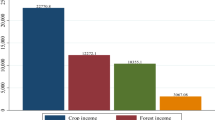Abstract
This study examines the species composition, diversity and economic importance of homestead forests in the household economy of central Bangladesh. The study documents 57 homestead forest species and their main usage in 90 households across three villages of Gazipur Sadar Upazila. Homestead forests in Bangladesh comprise a mixture of fruit, timber and bamboo species. While superficially homestead forestry appears unimportant in rural livelihoods, in reality the contribution is huge, both as a source of food security and for other necessary household materials. A clear understanding of the physical characteristics and economic role of homestead forests in rural livelihoods is vital for ensuring sustainable resource management. Income and production of homestead forestry on a per hectare basis are found to vary widely between landholding size classes. Significant relationships are identified between forest performance (production and income) and species richness and education level. Homestead forestry appears to be a potential subsistence income generating land-use practice in the study area. The economic scope of homestead forestry can be further enhanced provided the appropriate species composition of the forest is achieved and the education of forest owners is ensured through targeted management and policy interventions.
Similar content being viewed by others
References
Abedin, M.A., Lai, C.K. and Ali, M.O. (1988), Homestead plantation and agroforestry in Bangladesh, BARI/RWEDP/Winrocks, Dhaka.
Alam, M.K. (1997), ‘Domestication and conservation potential of homestead forests in Bangladesh’, in Proceedings of XI World Forestry Congress, Antalya, Turkey, Vol. 2, p. 203.
BBS (Bangladesh Bureau of Statistics) (1993), Bangladesh Population Census 1991, Zila: Gazipur, Government of Peoples Republic of Bangladesh (GOB), Dhaka.
BBS (Bangladesh Bureau of Statistics) (2000), 1998 Year Book of Agricultural Statistics, GOB, Dhaka.
BBS (Bangladesh Bureau of Statistics) (2001), Census of Agriculture, 1996, Zila Series-Gazipur, GOB, Dhaka.
BBS (Bangladesh Bureau of Statistics) (2003), Statistical Year Book 2001, GOB, Dhaka.
Bhuyan, H.H. (2004), Director, Census, Bangladesh Bureau of Statistics, Dhaka, personal communication.
Bunderson, T.W., Wakeel, A.E.L., Saad, Z.A. and Hashim, I. (1990), ‘Agroforestry practices and potential in Western Sudan’, in W.W. Budd, I. Ducchart, L.H. Hardsesty and F. Steiner (eds), Planning for Agroforestry, Elsevier, Oxford, pp. 227–246.
Champion, H.G., Seth, S.K. and Khattak, G.M. (1965), Forest Types of Pakistan, Pakistan Forestry Institute, Peshawar.
Christanty, L. (1985), ‘Homegardens in tropical Asia: a special reference to Indonesia’, a paper presented at the First International Workshop on Tropical Homegardens, Institute of Ecology, Padjadjaran University, Bandung, Indonesia.
Christanty, L., Abdoellah, O.S., Marten, G.G. and Iskandar, J. (1986), ‘Traditional agroforestry in West Java: the pekarangan (homegardens) and kebun-talun (annual-perennial rotation) cropping systems’, in G.G. Marten (ed.), Traditional Agriculture in Southeast Asia, Boulder, Colorado, pp. 132–158.
Douglas, J.J. (1981), ‘Supply and demand of forest products and future development strategies’, Field Document No. 2, UNDP/FAO/Planning Commission (GOB Project BGD/78/010, FAO, Rome.
Giovannetti, M., Sbrana, C, Avio, L. and Strani, P. (2004), ‘patterns of below-ground plant interactions established by means of arbuscular mycorrhizal networks’, New Phytologist, 164(1): 175–181.
GOB (Government of Peoples Republic of Bangladesh) (1992), Forestry Master Plan (Forest Policy), Ministry of Environment and Forests, Dhaka.
GOB (1995), Forest Policy of 1994, Bangladesh Gazette, 6 July 1995, pp. 241–244, Dhaka.
GOB (1993), Forestry Master Plan (Environment and Land use), Ministry of Environment and Forests, Dhaka.
GOB (1998), The Fifth five Year Plan (1997–2002), Planning Commission, Ministry of Planning, Dhaka.
Hochegger, K. (1998), Farming like the Forest: The Traditional Home Garden System in Srilanka, Margraf, Weikersheim, Germany, pp. 203.
Karyono (1990), ‘Home Gardens in Java: their structure and function’, in K. Landauuer and M. Brazil (eds), Tropical Home Gardens, The United Nations University, Tokyo, pp. 138–146.
Motiur, M.R., Tsukamoto, J., Furukawa, Y., Kawata, I., Rahman, M.M. and Alam, M. (2004), Diversity of Forest Tree Species of Tropical Moist Deciduous Forest of Madhupur Tract of Central Bangladesh, unpublished report, Kochi University, Japan.
Motiur, M.R., Tsukamoto, J., Furukawa, Y., Shibayama, Z. and Kawata, I. (2005), ‘Quantitative stand structure of woody components of homestead forests and its implications on silvicultural management, a case study in Sylhet Sadar Upazila, Bangladesh’, Journal of Forest Research, 10(4): 285–294, The Japanese Forestry Society and Springer-Verlag, Tokyo.
Millat-e-Mustafa, M.D., Hall, J.B. and Tklehaimanot, Z. (1996), ‘Structure and floristics of Bangladesh homegardens’, Agroforestry Systems, 33(3): 263–280.
Odum, E.P. (1971), Fundamentals of Ecology, 3rd edn, Toppan Printing Company, Tokyo.
Pielou, E.C. (1966), ‘The measurement of diversity in different types of biological collections’, Journal of Theoretical Biology, 13:131–144.
Price, N. (1982), ‘he tropical mixed garden: an agroforestry component of the small farm’, in N. Price, (ed.), Agroforestry for Humid Tropics, p. 40, CATIE, Turrilba, Costa Rica.
Salam, M.A., Noguchi, T. and Koike, M. (2000), ‘Understanding why farmers plant trees in the homestead agroforestry in Bangladesh’, Agroforestry Systems, 50(1): 77–93.
Singh, C.D. (2000), ‘Valuation and evaluation of trees outside of the forest (TOF) of Bangladesh’, draft paper for a regional study for Asia and Pacific in contribution to the Forest Resource Assessment (FRA), FAO, Rome.
Soemarwoto, O. (1987), ‘Homegardens: a traditional agroforestry system with promising future’, in H.A. Steppler and P.K.R.Nair (eds), A Decade of Development, ICRAF, Nairobi, pp. 157–170.
Author information
Authors and Affiliations
Rights and permissions
About this article
Cite this article
Rahman, M.M., Furukawa, Y., Kawata, I. et al. Homestead forest resources and their role in household economy: A case study in the villages of Gazipur Sadar Upazila of central Bangladesh. Small-scale Forestry 4, 359–376 (2005). https://doi.org/10.1007/s11842-005-0022-9
Issue Date:
DOI: https://doi.org/10.1007/s11842-005-0022-9




